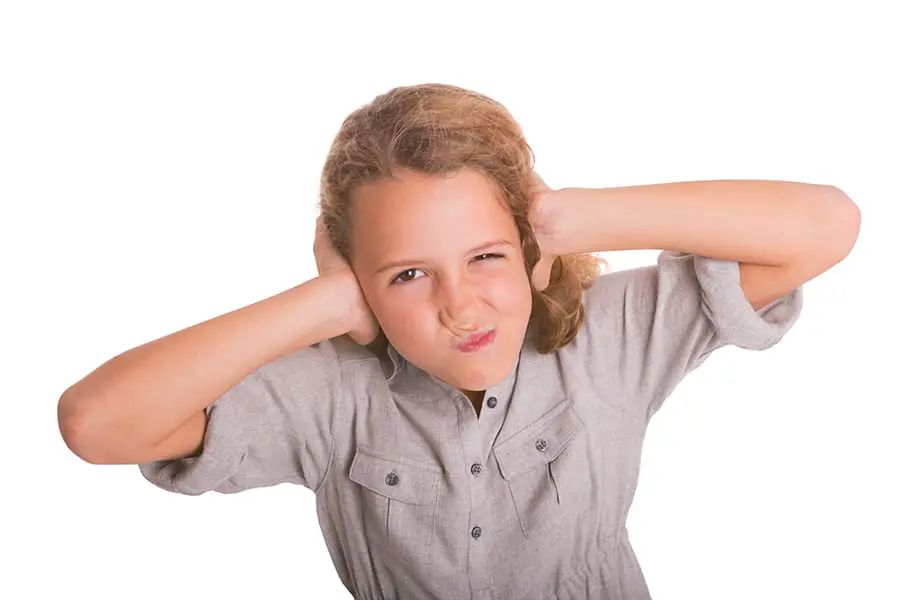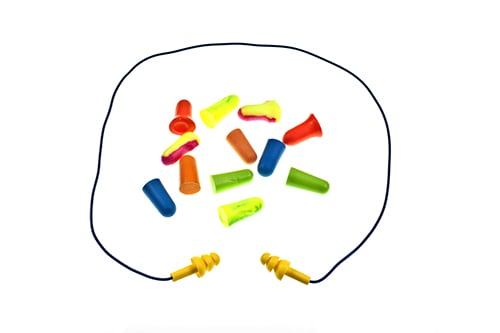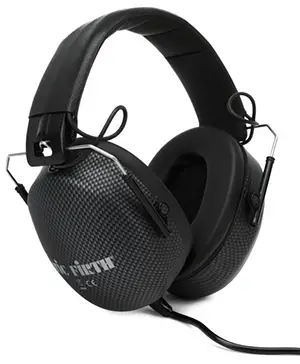
As a drum instructor, I always preached the importance of hearing protection for my students, especially those under a certain age. This advice was always followed by a few recommendations to for parents on their options for hearing protection, which I thought I would compile for you here.
Safe and Effective Hearing Protection Options for Kid Drummers:
- Good: Foam Earplugs
- Better: Noise Reduction Ear Muffs
- Best: Drummer Headphones
- Even Better: Custom Fit Earphones (In-Ear Monitors)
Let’s dig into the details of why hearing protection is so important before we dig into each option, including pros and cons so that you can take the worry out of protecting your kiddos ears.
The Basics of Hearing Protection
The human ear is a pretty amazing organ and one which we don’t think about too often as we tend to take it for granted. I won’t go into the details here of how our ears actually work, but I do think it’s important to highlight that our ears actually have a bit of hearing protection built in.
Now don’t get me wrong here, damage to our ears can occur at any time with any loud sounds, no matter how long in duration they are. That said, our ears will actually do a decent job of protecting us from short bursts of loud volume noise.
What is most dangerous though is prolonged and unprotected exposure to loud volume. Similar to how your skin won’t necessarily burn when exposed to the sun for a couple of minutes, our ears can withstand reasonably loud volume sounds for a short amount of time.
Attending concerts, visiting construction sites and practicing drums are all examples of prolonged exposure to loud sounds and should therefore be accompanied by effective hearing protection in the form of ear plugs, ear muffs, or noise reduction headphones.
The reason why this is especially critical in young children is that their ears, while not necessarily more sensitive to loud sounds, are more susceptible to ear damage primarily because their skulls are thinner and less developed than those of an adult.
Long story short: hearing protection is NEVER a bad idea no matter who you are, but because our children (especially infants and really young children) don’t always have the capacity to choose to wear hearing protection, we as adults must take that responsibility on for them.
Suggested Reading: I did some research on tinnitus (ringing in the ears) specifically for drummers and wrote an article about it, which you might find interesting.
and wrote an article about it, which you might find interesting.
What follows is a run-down of the most common hearing protection solutions for kids.
Good: Foam Ear Plugs

| Pros | Cons |
| Very Inexpensive | Limits your headphone options |
| Portable | Can be uncomfortable for little kiddo ears |
| Easily attainable | Potentially difficult to put in |
While there are several different styles of these earplugs, they all basically function the same and I’m willing to bet that the majority of you have used them in the past. In case you haven’t, their use is quite easy: roll the cylinder up tight, insert it into your ear and let it expand.
If you’ve put them in correctly, you’ll notice an immediate drop in the volume levels of basically everything. Important: With kids, it is especially important to teach them this trick so that they know when an ear plug is put in correctly.
The difficulty for kids to put these in correctly is definitely a big ‘con’ for the use of these ear plugs, despite their low cost and availability.
Better: Noise Reduction Ear Muffs
| Pros | Cons |
| Inexpensive (~$20) | Not headphones (not electronic) |
| Available in child sizes | Sometimes bulky |
| Easy and comfortable to wear | Pay attention to sizing |
Not to be confused with noise cancelling headphones (see more on this topic below) or even just plain headphones, noise reduction ear muffs are essentially the same type of headset worn by airport ground crew, someone at a shooting range or in any other loud environment.
are essentially the same type of headset worn by airport ground crew, someone at a shooting range or in any other loud environment.
These aren’t headphones in that they don’t have speakers or can’t be plugged in, but are singular in function: they provide safe and effective noise reduction at a relatively low price.
They are typically adjustable and come in both adult and child sizes. This latter point is important because if the ear muffs don’t fit properly, the noise reduction benefits are compromised.
This option is great if whoever will be wearing them doesn’t have to listen to music or a metronome through the headphones. They can also be great for kids who aren’t comfortable with putting foam ear plugs into their ears.
Best: Drummer Headphones or Earphones
| Pros | Cons |
| Hearing protection and headphones in one! | More expensive than basic solutions |
| Under $100 | May be too large for kids |
| Easy and comfortable to wear |
These solutions have always been my favorite recommendation BY FAR! Why? Well, for starters, they are purpose-made and encompass both great noise reduction and great sounding headphones.
This allows young drummers to protect their ears while still being able to hear a metronome or their favorite tunes through their headphones.
What’s even better is that these products have come down in price pretty dramatically over the years. I typically point folks towards Vic Firth drummer headphones or a nice set of noise reduction earphones
or a nice set of noise reduction earphones , both of which cost about the price of one or two drum lessons!
, both of which cost about the price of one or two drum lessons!
The only real downside here is that sometimes, the headphones especially are just a bit too big for our younger drummers. I’d say that you’re probably in good shape starting at age 9+, but it really just depends on the size of your kiddo.
Even Better: Custom Fit Earphones (In Ear Monitors)
| Pros | Cons |
| Superior sound quality and noise reduction | Super expensive ($1,000+) |
| The ‘professional’ option | Requires custom fitting |
Last but not least, I wanted to present you with the Cadillac of options, the in-ear monitor. These are the types of earphones you see professional musicians wearing (and let’s be honest, sometimes struggling with) on stage during shows or on TV.
These products, while they have excellent sound quality and noise reduction characteristics, tend to be insanely expensive and therefore out of reach for most novice and child musicians.
Additionally, they do require ear pieces to be custom fit/molded to the ear, which is an additional expense.
My advice? Unless you’re the drummer for Arianna Grande – steer clear. You can get amazing results for a fraction of the cost by going with off-the-shelf products.
A Word Of Caution: Avoid Anything Listed as “Noise Cancelling”
Over the past decade or so, noise cancelling headphones have become all the rage. It’s fantastic technology, but is meant for a completely different purpose than what we are discussing here.
Noise Cancellation is the process whereby headphones will actively ‘listen’ to the ambient noise around you and produce a the same sounds right back to you, but out of phase.
This cancels out the ambient noise coming into your ears and you’re left with noticeably softer background sounds. But that’s just it – they are meant to reduce the volume of background noise, not a super loud rock band (or drummer for that matter).
This is why I recommend you avoid this type of headset when looking for hearing protection. While yes, the noise coming in from outside will be reduced by the ear surrounds on the headphones themselves, the loud sounds themselves won’t be cancelled out and you’ll likely not get the level of hearing protection you’re after.
It’s A Matter of Education
Education plays a huge role in protecting a child’s ears from loud sounds of any kind. Stressing the importance of hearing protection from an early age can really make a long-term difference in someone’s hearing down the road.
The Cool Factor: A common objection I have often encountered (and I myself at a young age was guilty of) was that ear plugs & headphones sometimes just don’t look cool!
As a kiddo, sometimes all you want to do is to have fun and just rock out! The problem comes afterward though when your ears start ringing and your ears feel fatigued.
Educating your children about hearing protection is not just about talking with them about the long-term effects of loud volume on the ears. You should concentrate instead on changing the negative perception that hearing protection can have among teens especially.
This can be accomplished, among other ways, by making the act of putting ear plugs in a part of a pre-practice/pre-jamming ritual and using other musicians your child idolizes who use hearing protection (hint: pretty much all of them) as role models.
Related Questions
Can Kids Use Ear Plugs? Kids can use ear plugs however, they can be difficult for children to put in their ears properly. This is why a good set of noise reduction ear muffs is a great alternative.
Can Babies Use Ear Plugs? Ear plugs are NOT recommended for babies because their ear canals are generally too small to fit foam ear plugs, not to mention that they are a choking hazard.
Are Children’s Ears More Sensitive? Kids ears are generally not more sensitive than an adult’s however, because children have thinner skulls, it is more dangerous for young kids to be exposed to loud sounds.



